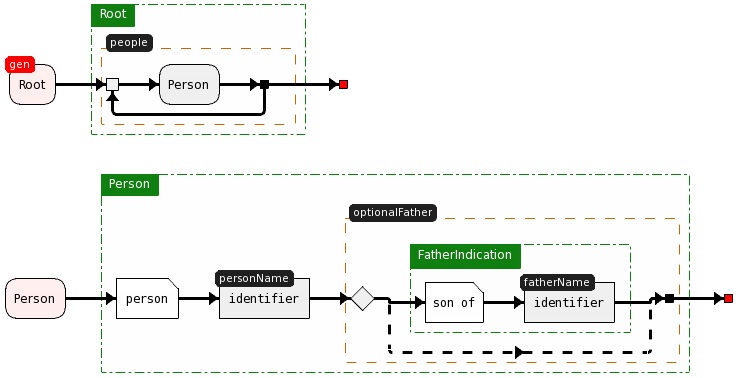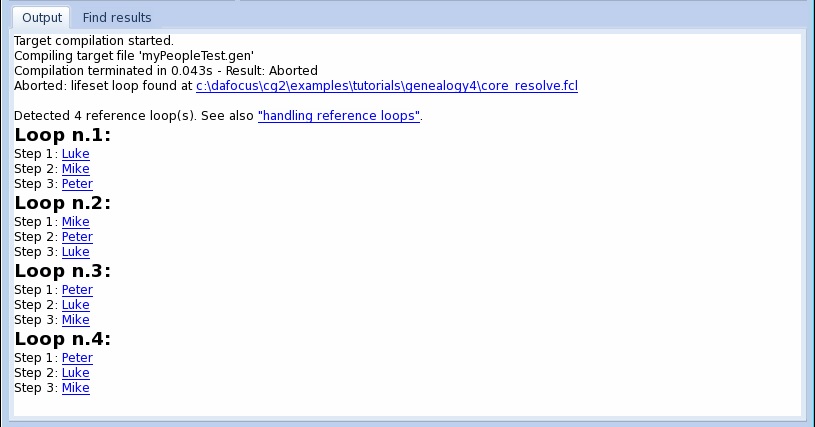Semantic analysis
1 Semantic analysis
In the previous books we worked with languages that were so simple that they required no semantic analysis at all. To understand what semantic analysis is and why we need it, we shall move to a new example of a custom language.
Let's create a language called Genealogy that allows us to define a family tree. The language syntax will have to look like this:
person Mike person John son of Mike person Luke son of Mike person Peter son of Luke
As we know, Macrocoder takes care of the syntax checking. For example, we will not be able to write person Mike father of John because father of is not one of the keywords we defined in our language. However, besides that, we can expect syntactically perfect source code that contains errors. For example, we could write:
person Mike son of John person John son of Mike
Although this code respects the syntax, it contains an obvious error: if Mike is John's father, John can not be Mike's father!
These kind of errors are called semantic errors because their detection depends on the logic meaning (called semantics) of the concepts expressed by the syntax.
This is the complete list of the semantic rules we need to enforce:
- every person has a unique name (i.e. only one
person xis allowed for everyx); - some people might optionally have indication of their father name;
- if a person has his father indicated, his father must have been defined with person;
- the graph formed by the father-son relatioship must be a tree, i.e. it must be acyclic (if Mike is John's father, John can not be Mike's father);
In this book we shall leave code generation temporarily aside and concentrate on semantic analysis.
1.1 Preparing the "Genealogy" language
By using the concepts learned from the previous chapters, we can definine the Genealogy language, so far still without any semantic check. We begin with the grammar (file grammar.fcg):

Then we can define the very simple CORE::Person class in the core.fcl file:
lifeset CORE;
class Person {
// Unique name of this person
LocString personName;
// Name of the father or empty if not indicated
LocString fatherName;
}
CORE class for the Genealogy project.Then we need a createCore phase that creates the CORE objects from the GRAMMAR (file grammar_createCore.fcl):
grammar GRAMMAR;
father-first phase createCore = 1 creates CORE;
extend class Person {
in phase createCore {
link of CORE::Person itsCorePerson;
do {
var CORE::Person corePerson;
itsCorePerson.set (corePerson);
corePerson.personName.set (personName);
lset.CORE.enroll (corePerson);
}
}
}
extend class FatherIndication {
in phase createCore do {
upscan(Person).itsCorePerson.fatherName.set (fatherName);
}
}
Finally we add a print phase in the core_print.fcl file just to see something when we will try it:
lifeset CORE;
phase print = 10;
extend class Person {
in phase print do {
system().msg << "person " << personName;
if (fatherName.text.length () > 0) {
system().msg << " son on " << fatherName;
}
system().msg << endl;
}
}
If we run the example of figure 1.1, we will obtain the following output:

Obviously, no semantic checks are implemented so far. Therefore, if we refer to unexisting parents or we define the same person twice, it will not complain.
The complete rules and target projects for at this stage can be downloaded at this link: Genealogy1.zip.
1.2 Checking names duplication
The first semantic check we will implement is to verify that the same person name is not used more than once.
This feature is obtained by using a lookup table, implemented by the Macrocoder composed type lookup_s of .... That composite type creates an indexed table where the key is a LocString and the value is a link to an object whose type has been specified. Let's do the magic (file core_register.fcl):
lifeset CORE;
father-first phase register = 1;
in phase register {
shared lookup_s of Person knownPeople;
}
extend class Person {
in phase register do {
lset.knownPeople.set (personName, this);
}
}
Let's look at the code:
- line 3: we defined the
registerphase; in this case,father-firstorchildren-firstdoes not matter; - lines 5-7: we added an
in phasestatement at root level, i.e. out of any class definition; this means that we added thein phaseto the lifeset class itself; in this way, the attributeknownPeoplewill be instanced once together with the lifeset singleton and it will be accessibile aslset.knownPeople; - line 6: the
knownPeopleattribute has been declared asshared; this means that the contents of this attribute will be updated during theregisterphase by the children and not by the owner itself; - line 11: the
Personclass has been extended to implement phaseregister; during that phase, it reaches the lifeset singletonlset, from there i reaches the global instance of the lookup tableknownPeopleand registers itself by specifyingpersonNameas the key andthisas the referenced object.
The method set of the lookup_s composite type detects and reports any duplication automatically.
Let's try to submit a target source containing a couple of duplications:
person Mike person John son of Mike person Luke son of Mike person Peter son of Luke person Mike person Peter son of Mike
The last two lines are dupes of names declared before. If we run Macrocoder now, it will report:

Note that the dupe names are colored in blue: by clicking on them, the editor will jump directly on the spot where those names have been defined in the target source code.
The complete rules and target projects for at this stage can be downloaded at this link: Genealogy2.zip.
1.3 Verifying fathers' existence
Next semantic check will report unexising fathers. To do that, we shall reuse the knownPeople lookup table we already created in the previous step. We can create another source file named core_resolve.fcl:
lifeset CORE;
father-first phase resolve = 2;
extend class Person {
in phase resolve {
do {
if (fatherName.text.length () > 0) {
lset.knownPeople.get (fatherName);
}
}
}
}
The action is all at lines 8 and 9: if the fatherName is not empty (i.e., if the user specified a father for this person), the method will look for an object having key fatherName in the global lookup table lset.knownPeople. If the key is not found, Macrocoder will complain with an error.
In the following example, the person at the last line refers to an unexisting father named "Marcus":
person Mike person John son of Mike person Luke son of Mike person Peter son of Luke person Brian son of Marcus
The last two lines are dupes of names declared before. If we run Macrocoder now, it will report:

1.4 Avoiding loops
The last check we need to implement is loop verification. The semantic check has to ensure that no one is defined as parent of one of his upper relatives, no matter how far in the parenthood chain.
This is obtained with a very simple modification. The changed lines are evidenced:
lifeset CORE;
father-first phase resolve = 2;
extend class Person {
in phase resolve {
dependent link of Person myParent;
do {
if (fatherName.text.length () > 0) {
myParent.set (lset.knownPeople.get (fatherName), fatherName);
}
}
}
}
The changes are very simple:
- line 7: a
dependent linkattribute has been added; a dependent link is a link that automatically verifies that no loops occur; - line 10: the reference to the father
Personobject returned by thegetmethod of the lookup table, which was previously discarded, now is assigned to the dependent linkmyParent;
With this modification, at the end of phase resolve every instance of Person that has a parent, will have a pointer to the parent Person object stored in myParent. Being the myParent link defined as "dependent", Macrocoder will make sure that no loops occur among these instances.
In the following example, all the four listed people are involved in a loop:
person Mike son of Peter person John son of Mike person Luke son of Mike person Peter son of Luke
When started, Macrocoder will abort the execution reporting the loops:

Note that at line 10 of figure 1.4.1 the set method of the dependent link has been called with two parameters:
myParent.set (lset.knownPeople.get (fatherName), fatherName)- first parameter queries the golbal lookup table knownPeople and retrieves the parent Person instance which becomes the target of the link (i.e. the object at which the link points to);myParent.set (lset.knownPeople.get (fatherName), fatherName)- second parameter is a LocString that contains the text that has to be displayed to represent this object in the error message in case a loop is detetcted; thanks to this string, a meaningful description, useful to fix the loop, of the involved objects can be given to the target user.
2 Summary
In this book we have covered the following concepts about Macrocoder programming:
- semantic analysis checks for errors due to violation of the conceptual rules, like reference to unexisting names or loops within parentship;
- names uniqueness can be verified by using a dedicated phase and registering all names in a global lookup_s table; the table will automatically report errors;
- referenced names existence can be verified using a dedicated phase and searching for the names in the table created in the step before;
- loops are checked by mean of a dependent link;